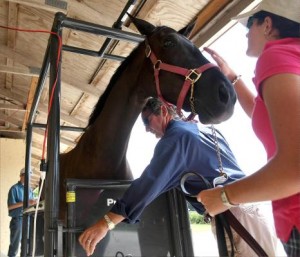Lucinda Fredericks (human on right) hopes to ride her mare Headley Britannia (center) in the Olympics this summer. The other two mares, Bear and Pippa, will be carrying the star event horse’s foals, sired by French show jumper Jaguar Mail.
It was a wry chuckle heard round the horse world: On April 1, the venerable British horse sports weekly Horse and Hound stuck its tongue in its veddy Briddish cheek and announced that an exclusive new four-star three-day event would be held in England. What’s the hitch? All entrants must prove that record-setting Badminton and Burghley winner Headley Britannia is their mother. April Fool!
Or was it?
In reality, both Headley Britannia and her semen-provider-by-courier, the top French show-jumping stallion Jaguar Mail, could both be competing in Hong Kong at the Olympics this summer, while their offspring are in utero back home in England, thanks to receiver mares. Their first foal was born to the surrogate dam this spring and is already being syndicated by Headley Brittania’s owner, Australian team rider Lucinda Fredericks.
One can joke about the popularity of embryo transfer in performance horses, but the reality is that more and more owners of valuable mares–regardless of age–are opting to use their horses as cash cows while the market is strong for sport or performance horses of fashionable bloodlines.
Embryo transfer calls for the breeding of the mare, usually by artificial insemination, when she comes into her normal cycle. The developing embryo is then flushed from her uterus and implanted in a receiver or “surrogate” mare whose cycle coincides with the genetic mother’s. The surrogate is often a less valuable horse who might not normally be reproducing. The genetic mother mare is back in training within a few weeks of the breeding and never suffers any of the risks or hardships of pregnancy or motherhood.
Embryo transfer can be done any number of times and there seems to be no limit to the embryos a mare can produce (hence the jokes about Headley Britannia), other than that only one embryo per cycle can be harvested.
The new technology means that mare owners can potentially receive some financial rewards from the mare, just as performance stallion owners harvest semen during a break from showing.
Embryo transfer in the USA took off in Texas and Oklahoma about ten years ago with the reining and cutting horse mares and now owners of show jumpers and dressage mares are lining up for the breeding stocks. Palm Beach Equine Clinic in Wellington, Florida recently acquired a reproduction-specialty facility in Aiken, South Carolina where 90 receiver mares are stabled and undergo the inbound transfer. The embryos travel by Federal Express from Wellington.
Mare owners can breed a young mare a couple of times a year, with potential for more than 15 years of multiple offspring without losing performance time. Mares as young as two may be bred.
There are ethical concerns, of course. In this age of unwanted horses and uncertain finances, do we really need to mushroom the foal crop of warmbloods? Should the ethical decision of “to breed or not to breed” be based on the perceived monetary value of a horse? Is it ok to keep flushing embryos out of an unsound mare if the owner happens to be able to acquire some semen from a fashionable European sire? Are mare owners shrinking the gene pool?
Many mares in training have been on hormones or Regumate-type steroid compounds to control their cycles, and now the trend is to revert to encouraging cycling again, when and if it is convenient, of course.
Many people opted out of breeding this year because they have believed the information fed to them that there is an over-population of horses in this country. Many people are opting for expensive surgery and special shoes and rehab programs for injured horses rather than engaging in the “throw away” economy of horse ownership in which trainers pressure owners to always have a number of horses in training for different divisions or of different ages.
There are no regulations on embryo transfer. If you think your mare is wonderful, and you can afford it, you can keep breeding her and keep flushing her, regardless of whether there is a potential market for her offspring.
The potential benefits of embryo transfer are huge for mares with good breeding value who should not or cannot task the risks of pregnancy or motherhood, particularly mares with laminitis, for whom full-term pregnancy can be painful or life-threatening.
Perhaps mare owners should go through ethical counseling before they make the decision to cash out their mares. Are they simply maximizing a cash investment or are they consciously breeding for the future of the American horse industry?
A demand has been created on the producer side and the veterinary profession is happy to oblige. Whether the demand exists on the buyer end of things remains to be seen. It’s a matter of dollars and sense.
To learn more: Read an article in today’s Palm Beach Post about the new embryo transfer services offered at Palm Beach Equine Clinic. The article includes a very good explanation of the process and how Palm Beach Equine is managing this new service.
Sport horse mares are better investments than ever, thanks to breeding technology. Palm Beach Post photo.









